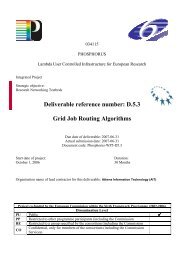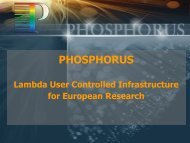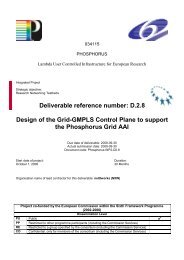D5.9: Extended Simulation Environment - Phosphorus
D5.9: Extended Simulation Environment - Phosphorus
D5.9: Extended Simulation Environment - Phosphorus
Create successful ePaper yourself
Turn your PDF publications into a flip-book with our unique Google optimized e-Paper software.
D5.6 - <strong>Extended</strong> <strong>Simulation</strong> <strong>Environment</strong><br />
1. Physical network topology, which is specified by loading a properly formatted (see Appendix for format<br />
specification of the topology file) topology file that among others contains number of switching nodes and<br />
the set of candidate fibre links with per link physical distance. The tool distribution made available includes<br />
topology files modelling the <strong>Phosphorus</strong> European and <strong>Phosphorus</strong> extended [2] topologies, as well as<br />
topology files modelling toy networks to be used for correctness testing.<br />
2. Assigning values to optical parameters e.g. bit rate. The application expects a file with optical parameter<br />
value assignments bundled in a MATLAB data file, named after “p1.mat” and located in the same directory<br />
as the main executable. The tool distribution supplied includes a “p1.mat” file that is per default used to<br />
assign values to the optical parameters of the network that is to be planned.<br />
3. Specifying a set of connection requests between node pairs of the input topology. The designed network,<br />
among other constraints, will be capable of fulfilling these connection requests. The input traffic matrix,<br />
contained in a properly formatted file (see Appendix for format specification of the traffic matrix file), is<br />
loaded by the user through the GUI interface of the tool. The tool distribution made available includes traffic<br />
files for the <strong>Phosphorus</strong> European and <strong>Phosphorus</strong> extended topologies, as well as traffic files modelling<br />
that are to be used with the toy network topologies provided.<br />
4. Specifying technology and routing parameters, namely number of wavelengths/fibre, maximum number of<br />
fibres allowed per physical link and number of alternative paths to be considered by the k-shortest path<br />
algorithm.<br />
5. Specify the cost parameter values, as mandated by the cost model extensively presented in [2].<br />
After all input data have been loaded/specified, the design method to be used to optimize the total cost in the<br />
optical WDM network needs to be selected among three alternatives (all presented in [2]):<br />
Network design/dimensioning without use of regenerators (“Basic” method)<br />
Network design/dimensioning with length-based regenerator placement<br />
Network design/dimensioning with impairment-aware regenerator placement<br />
The completion of all the above steps yields a well-defined instance of the network design/dimensioning<br />
problem that is solved by the NeDeTo tool to optimality, as soon as the user initiates the optimization process.<br />
The results of the optimization process are written to .mat MATLAB data files, whose structure is extensively<br />
specified later in this section. In addition, utilization of resources in the designed network is depicted using three<br />
graphs:<br />
1. Graph illustrating the utilization of alternative paths by each connection request, among the k alternative<br />
paths that can be taken by the k-shortest path algorithm used.<br />
2. Graph illustrating number of fibres installed per physical link in the designed network.<br />
Project:<br />
<strong>Phosphorus</strong><br />
Deliverable Number: <br />
Date of Issue: 2009-03-31<br />
EC Contract No.: 034115<br />
Document Code: <br />
25






